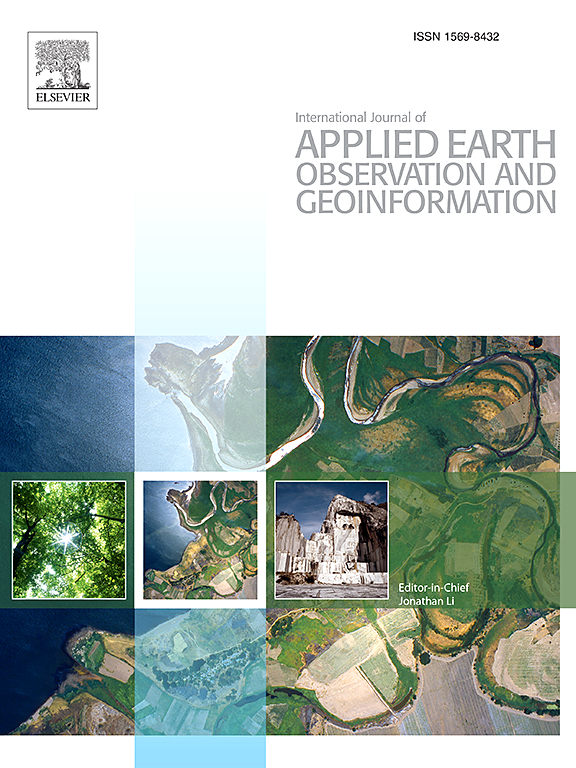Seasonal dynamics of hiking activities in mountainous areas: a topography-aware sequential network modeling approach using crowdsourced trajectories
IF 8.6
Q1 REMOTE SENSING
International journal of applied earth observation and geoinformation : ITC journal
Pub Date : 2025-07-12
DOI:10.1016/j.jag.2025.104726
引用次数: 0
Abstract
The growing popularity of hiking has intensified the interaction between urban areas and wilderness landscapes, highlighting the need for spatially-explicit models to quantify trail usage dynamics and alleviate ecological pressures in mountainous regions. This study investigates spatiotemporal hiking patterns in China’s Qinling Mountains (2020–2023) using crowdsourced GPS trajectories collected from outdoor sports Apps. The paper proposes a topography-aware sequential network model that accounts for terrain resistance and incorporates behaviorally significant feature points, enabling detailed analysis of seasonal dynamics in hiker movement patterns on informal trails in mountainous areas. Based on the network, the complex network analyses, we identify hiking hotspots, core hubs and critical paths, reveal the popular routes within network communities, and reconstruct the evolution of these communities over time. Key findings include: (1) three elevation-specific activity zones (at 1000 m, 2000 m, and 3500 m), (2) a significant increase in short-distance hiking activities. (3) 62 % of trails being used exclusively in a single season, and (4) summer networks showing superior connectivity. The discussion highlights strategies to balance ecological conservation with hiking tourism development, including key path management, regulation of seasonal visitor flows, and evidence-based planning for transportation infrastructure. These findings offer actionable insights for sustainable tourism, contributing to GIS-driven frameworks that promote human-nature coexistence in mountain ecosystems.
山区徒步活动的季节动态:使用众包轨迹的地形感知序列网络建模方法
徒步旅行的日益普及加剧了城市地区与荒野景观之间的相互作用,凸显了对空间明确模型的需求,以量化山区的步道使用动态和缓解生态压力。利用户外运动app收集的众包GPS轨迹,研究了2020-2023年中国秦岭地区徒步旅行的时空格局。本文提出了一个地形感知序列网络模型,该模型考虑了地形阻力,并结合了行为显著特征点,从而可以详细分析山区非正式步道上徒步旅行者运动模式的季节性动态。在网络、复杂网络分析的基础上,确定了徒步旅行热点、核心枢纽和关键路径,揭示了网络社区内的热门路线,并重构了这些社区随时间的演变。主要发现包括:(1)在海拔1000米、2000米和3500米有不同的活动区域;(2)短途徒步活动显著增加。(3) 62%的小径只在一个季节使用,(4)夏季网络显示出优越的连通性。讨论重点是平衡生态保护与徒步旅游发展的策略,包括关键路径管理、季节性游客流量调节和基于证据的交通基础设施规划。这些发现为可持续旅游业提供了可行的见解,有助于构建gis驱动的框架,促进山区生态系统中人与自然的共存。
本文章由计算机程序翻译,如有差异,请以英文原文为准。
求助全文
约1分钟内获得全文
求助全文
来源期刊

International journal of applied earth observation and geoinformation : ITC journal
Global and Planetary Change, Management, Monitoring, Policy and Law, Earth-Surface Processes, Computers in Earth Sciences
CiteScore
12.00
自引率
0.00%
发文量
0
审稿时长
77 days
期刊介绍:
The International Journal of Applied Earth Observation and Geoinformation publishes original papers that utilize earth observation data for natural resource and environmental inventory and management. These data primarily originate from remote sensing platforms, including satellites and aircraft, supplemented by surface and subsurface measurements. Addressing natural resources such as forests, agricultural land, soils, and water, as well as environmental concerns like biodiversity, land degradation, and hazards, the journal explores conceptual and data-driven approaches. It covers geoinformation themes like capturing, databasing, visualization, interpretation, data quality, and spatial uncertainty.
 求助内容:
求助内容: 应助结果提醒方式:
应助结果提醒方式:


